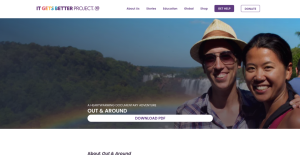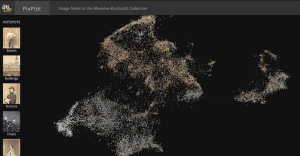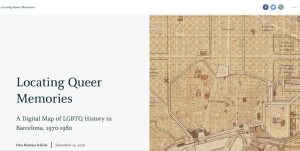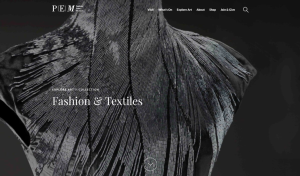General Interest
Back to Top
|
 |
|
Out and Around
|
Social studies |
|
"Let's have an adventure." In Out and Around, Jennifer Chang and Lisa Dazols invite viewers to join them on a journey through Australia, Asia, Africa and South America. Their year-long travels documented the state of LGBTQ+ rights around the world (though readers should note the film was released in 2015 and thus some of the specific laws referenced may have changed since). The documentary combines storytelling, social justice, human rights, and the great outdoors to tell both "an entertaining adventure story," and "an empowering account of LGBTQ+ resilience in an often complicated world." In addition to viewing the 80-minute documentary, readers can submit basic info (name and email) to gain access to the Educator Guide, a useful resource with 10 discussion prompts and 3 research project ideas focused on global LGBTQ+ rights. The guide is available in English, Chinese, Portugese, and Spanish. Readers will also find a few Bonus Material highlighted at the bottom of the page. The guide and documentary are available to a broad audience thanks to a partnership with the It Gets Better Project. [EMB] |
|





|
|
 |
|
Old English Online
|
Foreign Languages |
|
Old English, a language originating in early medieval England and a predecessor of modern English, has some unique features that may make it difficult to study. For example, Old English uses three letters that do not exist in modern English and does not use the letters j, v, w, or z. This resource helps readers understand and read the language, with useful tools for both novice and experienced Old English learners. Readers will find a Course Index, with topical modules on nouns, verbs, syntax, and more. There is also a Pronunciation Guide, which includes notes and embedded audio. The Home page links to a beginner's guide and a brief history, great starting points for new learners. Victoria Koivisto-Kokko created Old English Online in 2018 as a component of her master's thesis at the University College Cork. Funding was provided by the UCC National Forum's "Developing Disciplinary Excellence in Learning, Teaching and Assessment" fund. Dr. Tom Birkett also contributed to the project. As a "living resource," updates and changes are constantly being added. For more information on how users can contribute to this process, check out the FAQ section. [EMB] |
|





|
|
 |
|
Not Even Past: Social Vulnerability and the Legacy of Redlining
|
Social studies |
|
Long-standing subscribers may remember the 11-04-2016 Scout Report feature Mapping Inequality, a project from the University of Richmond's Digital Scholarship Lab that explored how the Home Owners' Loan Corporation's loan risk maps facilitated a racist lending system called "redlining." Now, readers can expand on the historical context provided by this and other related resources (for example, Redlining Louisville from the 10-02-2020 issue or Moving the Line from the 7-17-2020 issue) with Not Even Past, another Richmond DSL project (in collaboration with the National Community Reinvestment Coalition) that explores "the legacy of redlining," in conjunction with "racial health inequities." As this resource exemplifies, racist lending practices and segregated housing directly impact other health and wellbeing metrics; and, the challenges of COVID-19 have only deepened racial disparities. On the site, users are able to directly compare redlining maps with maps of the Center for Disease Control's Social Vulnerability Index (an assessment of "a community's capacity to prepare for, respond to, and recover from human and natural disasters,"). Maps for 200 cities are available, and readers will find detailed instructions on navigating the maps under the How to Use this Site sub-section of the landing page. [EMB] |
|





|
|
 |
|
PixPlot: Visualizing Image Fields
|
Social studies |
|
A project from the Yale Digital Humanities Lab (DH Lab), PixPlot uses 21st-century technology to explore a large collection of 19th- and 20th-century images, the Meserve-Kunhardt Collection at Yale's Beinecke Rare Book & Manuscript Library. Amassed by Frederick Hill Meserve, "a collector and distributor of photographs from 1897 to his death in 1962," the collection has a bevy of materials highlighting Abraham Lincoln and events around the time of the American Civil War. PixPlot analyzes the 27,000 images in the collections along more than 2,000 dimensions, resulting in a unique visual display that groups like images together. Users can navigate the resource by zooming in and out of clusters of interest or by expanding designated "hotspots" that each begin with a representative image identified by the software (e.g., buttons, gowns, landscapes, or suits). The resource is ever-evolving, and future planned enhancements include layouts based on user-provided metadata, basic search functionality, and text annotations within plots. To see the underlying code, visit the DHLab on GitHub. [DS] |
|





|
|
 |
|
Locating Queer Memories
|
Social studies |
|
Locating Queer Memories provides users with "a digital map of LGBTQ history in Barcelona, 1970-1980." Catalan-Canadian historian Ona Bantjes-Rafols created this project as part of a digital humanities course at Carleton University. In the project, she reflects on the "stories hidden in city streets," noting, as an example, the many times she passed the Rambla (a pedestrian street in central Barcelona) before learning its history as "the site of the very first gay rights march in the Spanish State." Then, she shares these stories with others, as cataloged by map pinpoints. Two maps are available. The first highlights stories specific to Barcelona. The second provides an international perspective, outlining cross-continental connections. Clicking on a pinpoint pulls up a quote, story, or excerpt detailing "queer life in Barcelona during the 1970s," from struggle to solidarity. Note that zooming in on sections of the map makes for an easier navigation experience. Readers will also find a brief essay providing Historical Context and a Bibliography. [EMB] |
|





|
|

















